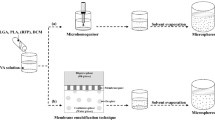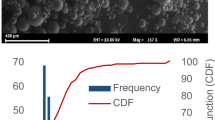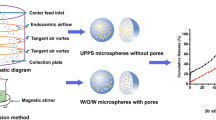Abstract
Purpose. The purpose of this study was to investigate the effect of the formulation parameters on the characteristics of dextran-based microspheres, prepared in an all-aqueous system.
Methods. Dextran microspheres were formed by polymerization of methacryloyl groups attached to dextran (dexMA), emulsified in an aqueous poly(ethylene glycol) (PEG) solution. DexMA/PEG/water phase diagrams were established.
Results. The binodals in the phase diagrams shifted to higher concentrations of dextran and PEG with decreasing molecular weight of both polymers, and with increasing degree of MA substitution. The volume-number mean diameter of the microspheres, varied between 2.5 and 20 μm. For a given formulation, the particle size was independent of the PEG/dexMA volume ratio > 40 and increased for volume ratios < 40. Furthermore, larger particles were obtained with decreasing viscosity of the continuous phase and increasing viscosity of the discontinuous phase.
Conclusions. Particle characteristics of dextran microspheres prepared in an all-aqueous system, among which the size and initial water content, can be tailored by adjusting the formulation parameters.
Similar content being viewed by others

REFERENCES
W. E. Hennink, H. Talsma, J. C. H. Borchert, S. C. de Smedt, and J. Demeester. Controlled release of proteins from dextran hydrogels. J. Contr. Rel. 39:47–55 (1996).
O. Franssen, O. P. Vos, and W. E. Hennink. Delayed release of a model protein from enzymatically-degrading dextran hydrogels. J. Contr. Rel. 44:237–245 (1997).
W. N. E. van Dijk-Wolthuis, J. J. Kettenes-van den Bosch, A. van der Kerk-van Hoof, and W. E. Hennink. Reaction of dextran with glycidyl methacrylate: An unexpected transesterification. Macromolecules 30: 411–3413 (1997).
O. Franssen and W. E. Hennink. A novel preparation method for polymeric microparticles without the use of organic solvents. Int. J. Pharm. in press (1998).
J. H. Eldridge, C. J. Hammond, J. A. Meulbroek, J. K. Staas, R. M. Gilley, and T. R. Rice. Controlled vaccine release in the gutassociated lymphoid tissues. I. Orally administered biodegradable microspheres target the Peyer's patches. J. Contr. Rel. 11:205–214 (1990).
B. C. Thanoo, W. J. Doll, R. C. Mehta, G. A. Digenis, and P. P. DeLuca. Biodegradable Indium-111 labeled microspheres for in vivo evaluation of distribution and elimination. Pharm. Res. 12:2060–2064 (1995).
M. Mora and J. Pato. Preparation of egg albumin microparticles for oral application. J. Contr. Rel. 25:107–113 (1993).
I. Sjoholm and P. Edman. Acrylic microspheres in vivo. I. Distribution and elimination of polyacrylamide microparticles after intravenous and intraperitoneal injection in mouse and rat. J. Pharmacol. Exp. Ther. 211:656–662 (1979).
C. Li, D. J. Yang, L. R. Kuang, and S. Wallace. Polyamino acid microspheres: preparation, characterization and distribution after intravenous injection in rats. Int. J. Pharm. 94:143–152 (1993).
P. A. Albertsson. Partition of cell-particles and macromolecules, Wiley-Interscience, New York, 1986.
C. A. Haynes, R. A. Beynon, R. S. King, H. W. Blanch, and J. M. Prausnitz. Thermodynamic properties of aqueous polymer solutions: poly(ethylene glycol)/dextran. J. Phys. Chem. 93:5612–5617 (1989).
H. Walter and G. Johansson. Partitioning in aqueous two-phase systems: an overview. Anal. Biochem. 155:215–242 (1986).
P. J. Flory. Principles of Polymer Chemistry, Cornell University Press, New York, 1953.
A. Gustafsson, H. Wennerstrom, and F. Tjerneld. The nature of phase separation in aqueous two-polymer systems. Polymer 27:1768–1770 (1986).
K. Gekko. Solution properties of polysaccharides, in: D. A. Brant (Ed.), ACS Symp. Ser. 150:415–438, American Chemical Society, Washington DC, 1981.
W. N. E. van Dijk-Wolthuis, O. Franssen, H. Talsma, M. J. van Steenbergen, J. J. Kettenes-van den Bosch, and W. E. Hennink. Synthesis, characterization and polymerization of glycidyl methacrylate derivatized dextran. Macromolecules 28:6317–6322 (1995).
S. P. Sanghvi and J. G. Nairn. Effect of viscosity and interfacial tension on particle size of cellulose acetate trimellitate microspheres. J. Microencapsulation 9:215–227 (1992).
Y. F. Maa and C. C. Hsu. Effect of primary emulsions on microsphere size and protein-loading in the double emulsion process. J. Microencapsulation 14:225–241 (1997).
Author information
Authors and Affiliations
Additional information
participant in the Groningen-Utrecht Institute for Drug Exploration (GUIDE)
Rights and permissions
About this article
Cite this article
Stenekes, R.J.H., Franssen, O., van Bommel, E.M.G. et al. The Preparation of Dextran Microspheres in an All-Aqueous System: Effect of the Formulation Parameters on Particle Characteristics. Pharm Res 15, 557–561 (1998). https://doi.org/10.1023/A:1011925709873
Issue Date:
DOI: https://doi.org/10.1023/A:1011925709873



